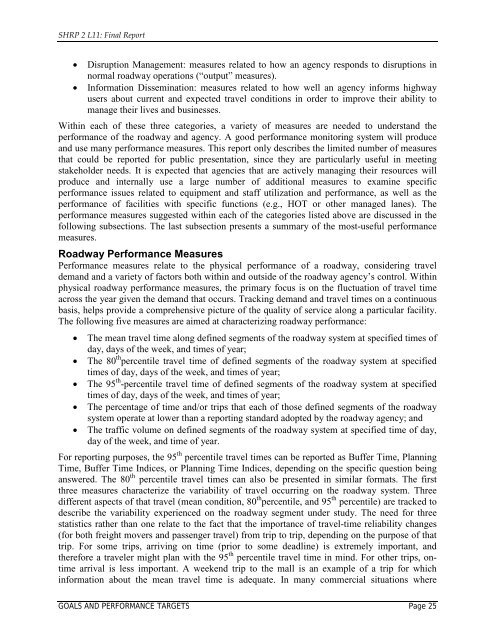Evaluating Alternative Operations Strategies to Improve Travel Time ...
Evaluating Alternative Operations Strategies to Improve Travel Time ...
Evaluating Alternative Operations Strategies to Improve Travel Time ...
Create successful ePaper yourself
Turn your PDF publications into a flip-book with our unique Google optimized e-Paper software.
SHRP 2 L11: Final Report<br />
• Disruption Management: measures related <strong>to</strong> how an agency responds <strong>to</strong> disruptions in<br />
normal roadway operations (“output” measures).<br />
• Information Dissemination: measures related <strong>to</strong> how well an agency informs highway<br />
users about current and expected travel conditions in order <strong>to</strong> improve their ability <strong>to</strong><br />
manage their lives and businesses.<br />
Within each of these three categories, a variety of measures are needed <strong>to</strong> understand the<br />
performance of the roadway and agency. A good performance moni<strong>to</strong>ring system will produce<br />
and use many performance measures. This report only describes the limited number of measures<br />
that could be reported for public presentation, since they are particularly useful in meeting<br />
stakeholder needs. It is expected that agencies that are actively managing their resources will<br />
produce and internally use a large number of additional measures <strong>to</strong> examine specific<br />
performance issues related <strong>to</strong> equipment and staff utilization and performance, as well as the<br />
performance of facilities with specific functions (e.g., HOT or other managed lanes). The<br />
performance measures suggested within each of the categories listed above are discussed in the<br />
following subsections. The last subsection presents a summary of the most-useful performance<br />
measures.<br />
Roadway Performance Measures<br />
Performance measures relate <strong>to</strong> the physical performance of a roadway, considering travel<br />
demand and a variety of fac<strong>to</strong>rs both within and outside of the roadway agency’s control. Within<br />
physical roadway performance measures, the primary focus is on the fluctuation of travel time<br />
across the year given the demand that occurs. Tracking demand and travel times on a continuous<br />
basis, helps provide a comprehensive picture of the quality of service along a particular facility.<br />
The following five measures are aimed at characterizing roadway performance:<br />
• The mean travel time along defined segments of the roadway system at specified times of<br />
day, days of the week, and times of year;<br />
• The 80 th percentile travel time of defined segments of the roadway system at specified<br />
times of day, days of the week, and times of year;<br />
• The 95 th -percentile travel time of defined segments of the roadway system at specified<br />
times of day, days of the week, and times of year;<br />
• The percentage of time and/or trips that each of those defined segments of the roadway<br />
system operate at lower than a reporting standard adopted by the roadway agency; and<br />
• The traffic volume on defined segments of the roadway system at specified time of day,<br />
day of the week, and time of year.<br />
For reporting purposes, the 95 th percentile travel times can be reported as Buffer <strong>Time</strong>, Planning<br />
<strong>Time</strong>, Buffer <strong>Time</strong> Indices, or Planning <strong>Time</strong> Indices, depending on the specific question being<br />
answered. The 80 th percentile travel times can also be presented in similar formats. The first<br />
three measures characterize the variability of travel occurring on the roadway system. Three<br />
different aspects of that travel (mean condition, 80 th percentile, and 95 th percentile) are tracked <strong>to</strong><br />
describe the variability experienced on the roadway segment under study. The need for three<br />
statistics rather than one relate <strong>to</strong> the fact that the importance of travel-time reliability changes<br />
(for both freight movers and passenger travel) from trip <strong>to</strong> trip, depending on the purpose of that<br />
trip. For some trips, arriving on time (prior <strong>to</strong> some deadline) is extremely important, and<br />
therefore a traveler might plan with the 95 th percentile travel time in mind. For other trips, ontime<br />
arrival is less important. A weekend trip <strong>to</strong> the mall is an example of a trip for which<br />
information about the mean travel time is adequate. In many commercial situations where<br />
GOALS AND PERFORMANCE TARGETS Page 25















